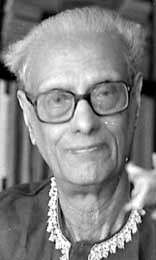Annada Shankar Ray

Annada Shankar Ray (May 15, 1904 in Dhenkanal, Orissa, India – October 28, 2002) was a Bengali and Odia poet and essayist.[1]
He graduated in English from Ravenshaw College in Cuttack. His father had shifted base from their ancestral village of Rameswarpur near Dhamnagar in Bhadrak of Orissa, following a family feud. His family roots go back to the 'Ghosh Mahashayas' who migrated to Rameswarpur from Kotarang near Howrah as a part of Todarmal's contingent during Akbar's reign.
He topped the list of Indian Civil Service examinees in 1927. He had failed to make the mark in the previous year, being cut off by one rank. It is said that he promised to his family and friends that if only one person was to be selected for ICS the next year, it would be himself, and he proved it. Incidentally, he was the first ICS officer from the territory later forming the state of Orissa.
After serving in various administrative posts, he sought voluntary retirement in 1951 to devote himself to literary pursuits. Ray was a Gandhian in politics and Rabindranath Tagore inspired his literature
A Bengali rendering of a short story by Tolstoy and an appraisal of Sarat Chandra Chattopadhyay’s essay "Narir Mulya" marked his debut on the literary scene at the age of 16.
His first published book was Tarunya (1928), which gave him a footing as an essayist. His first two novels were Asamapika and Agun Niye Khela. As an essayist, he was urbane and sophisticated and combined in his craft two different styles of prose, represented by Tagore and Pramatha Choudhury.
A significant breakthrough in his literary career came with the publication of Pathe Prabase, a diary of his Europe trip, in 1931.
Ray also established himself as a short-story writer. His collections include Prakritir Parihas (1934), Man Pavan (1946), Kamini Kanchan (1954) and Katha.
He received the Vidyasagar Smriti Award from the state government and the Padma Bhushan.[2] He was made a fellow of the Sahitya Akademi in 1989. The Visva Bharati conferred on him the Desikottama and an honorary D.Litt. He also received the Rabindra Puraskar, the Ananda Puraskar twice and the Zaibunnisa Award of Bangladesh.
He was a bitter opponent of the partition of 1947 and wrote several Bengali poems criticising it. Most notable is "Teler shishi bhaanglo bole khukur pare raag karo". Among his many essays, the book "Banglar Reneissance" has an analytical history of the cultural and social revolution in Bengal. His married Leela Ray, an Indianized American lady with literary talent. Annada Shankar's most famous work is Pathe Prabaase, a diary of his Europe trip in 1931.
From amongst his other works in Oriya, the poetry "Sabita" finds place in higher studies of the language at college level, making him one of the rare poets to have the distinction of getting such acclaim from two different language speaking states of India.
He died in Kolkata on 28 October 2002.
Life
Passed B.A. (Honors) in English from Ravenshaw College, Cuttack, Orissa. Started his literary career in Odia. He was a poet of Sabuja Yuga in Oriya Literature. Later he shifted his writing to Bengali. Annadashankar Roy was the first "native" Indian in British India to stand first in the I. C. S. examination, an achievement that is history and had excited thousands of patriotic natives at that time.
He married an American pianist called Alice Virginia Orndorf. After marriage Alice Virginia took the name Leela Roy.
Works
Annadashankar Roy was a contributor of both prose and poetry.
His literary works were included in the curriculum of school level, secondary, higher secondary and graduation level Bengali Literature in Bangladesh.
Novels
- Satyasatya (6 Novels)
- Jar Jetha Desh
- Oggatobash
- Kolonkoboti
- Dukkhomochon
- Morter Sorgo
- Opposaron
- Agun Niye Khela
- Osomapika
- Putul Niye Khela
- Na
- Konna
Essays
- Tarunno
- Amra
- Jibonshilpi
- Eahara
- Jiyonkathi
- Deshkalpatro
- Prottoy
- Notun Kore Bacha
- Adhunikota
Autobiography
- Binur Boi
- Potheprobashe
- Japane
Short story collections
- Prokritir Porihash
- Du Kan Kata
- Hason Sakhi
- Mon Pahon
- Jouban Jala
- Kamini Kanchon
- Ruper Day
- Golpo
References
- ↑ "Annadashankar Roy". www.southasianmedia.net. Archived from the original on September 8, 2006. Retrieved 2006-10-24.
- ↑ "Padma Awards" (PDF). Ministry of Home Affairs, Government of India. 2015. Archived from the original (PDF) on November 15, 2014. Retrieved July 21, 2015.
- Golpo Songroho (Collected Stories), the national textbook of B.A. (pass and subsidiary) course of Bangladesh, published by University of Dhaka in 1979 (reprint in 1986).
- Bangla Sahitya (Bengali Literature), the national textbook of intermediate (college) level of Bangladesh published in 1996 by all educational boards.
External links
- https://web.archive.org/web/20070927200703/http://www.calcuttaweb.com/cgi-bin/picdispgeneral.pl?/kabita/teler_sisi.gif
- http://www.telegraphindia.com/1021029/asp/bengal/story_1334876.asp
